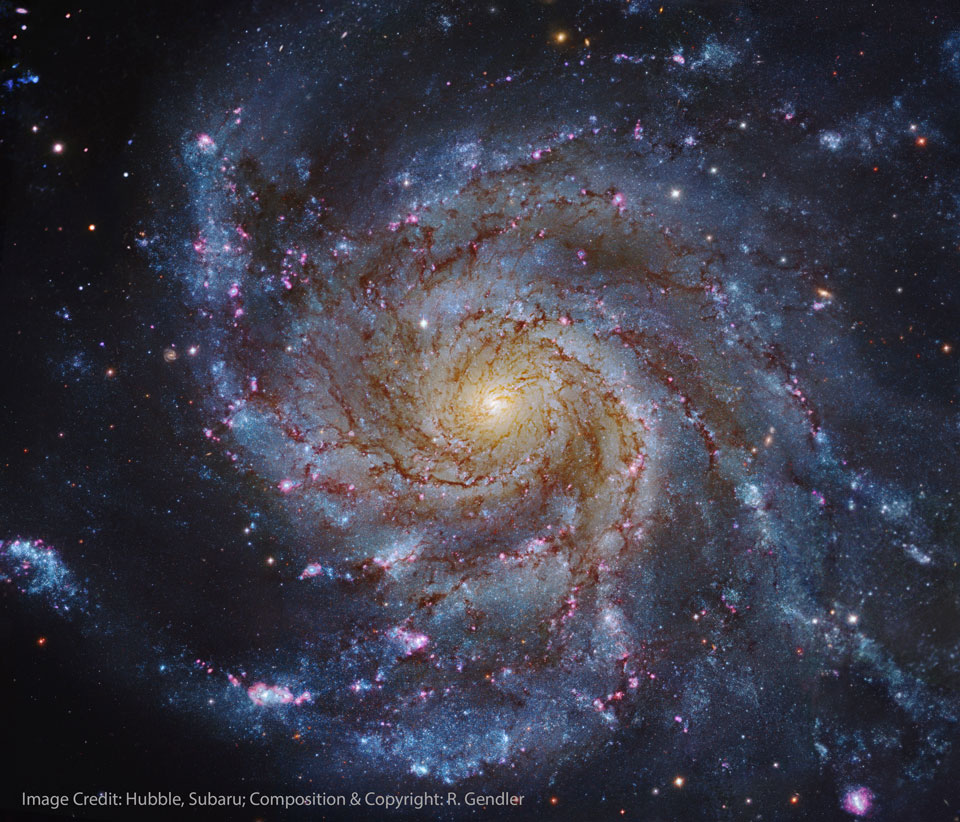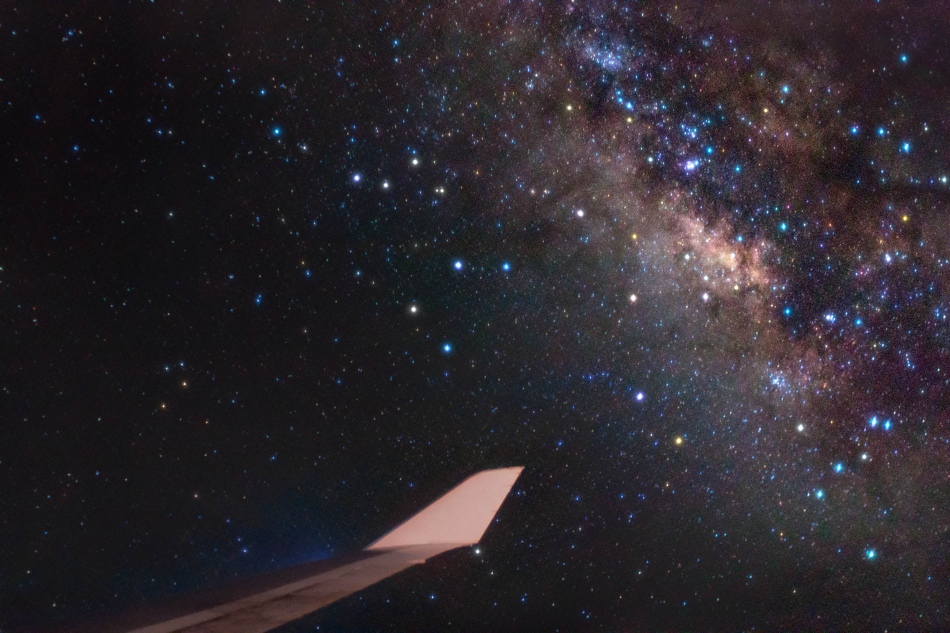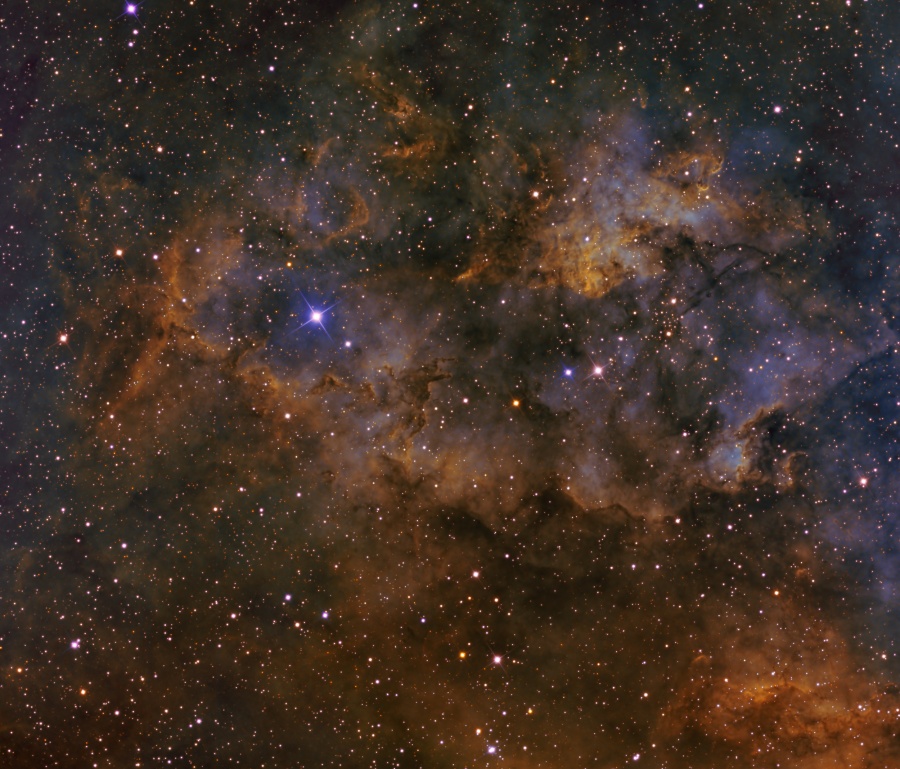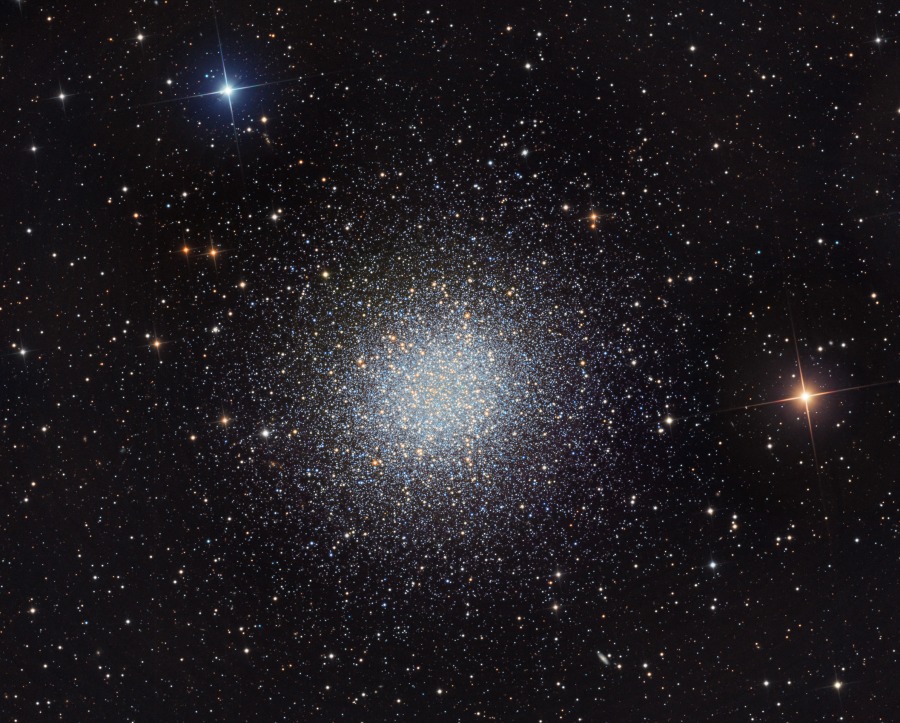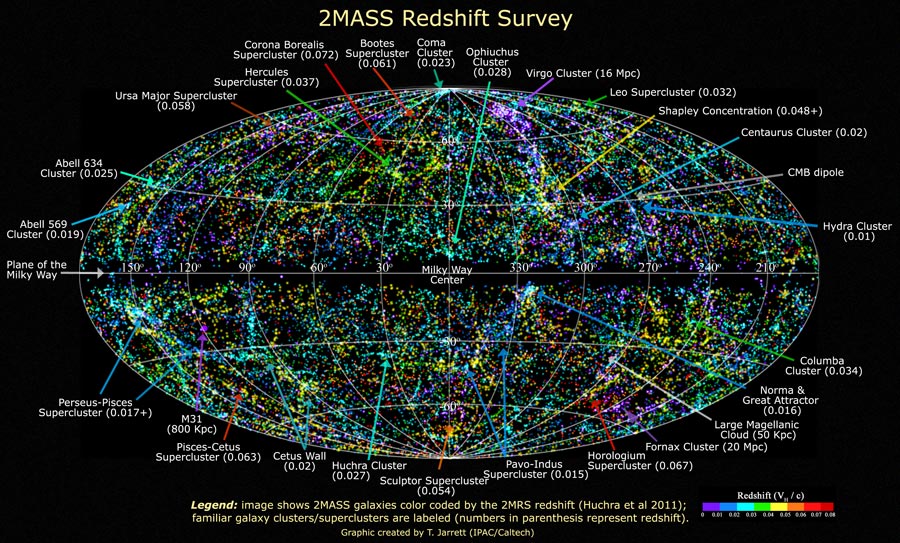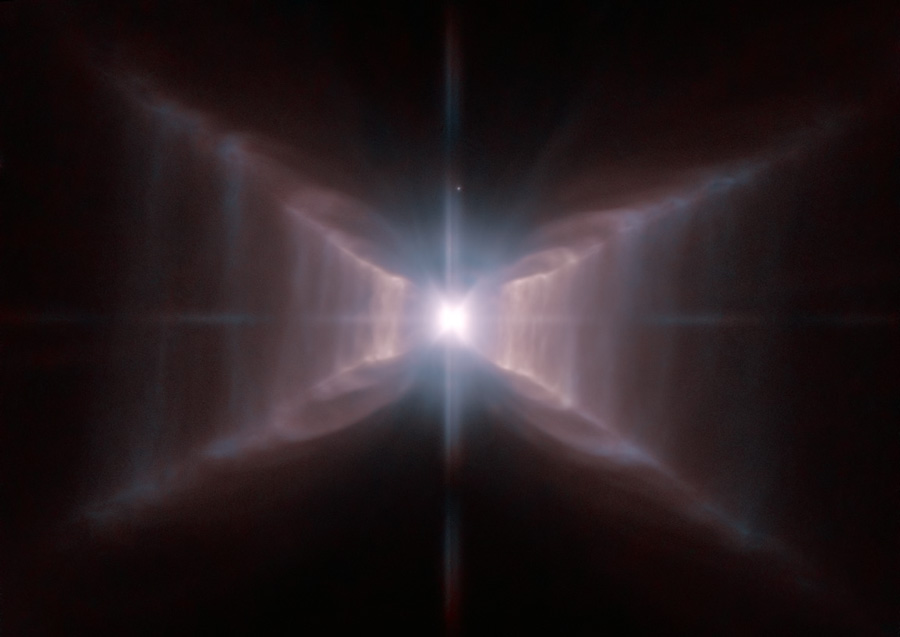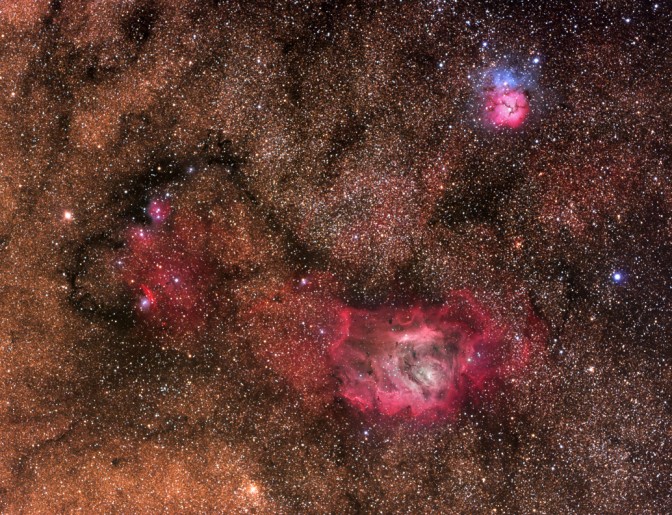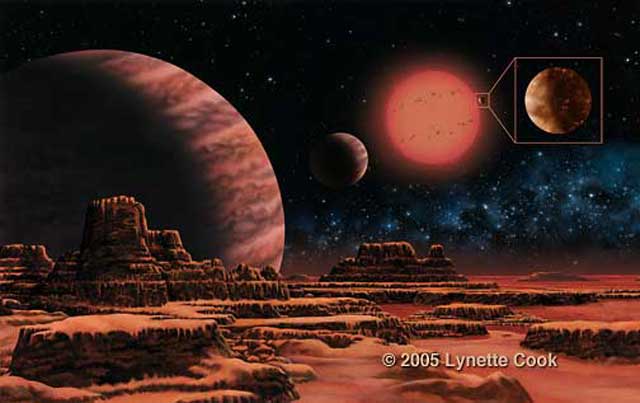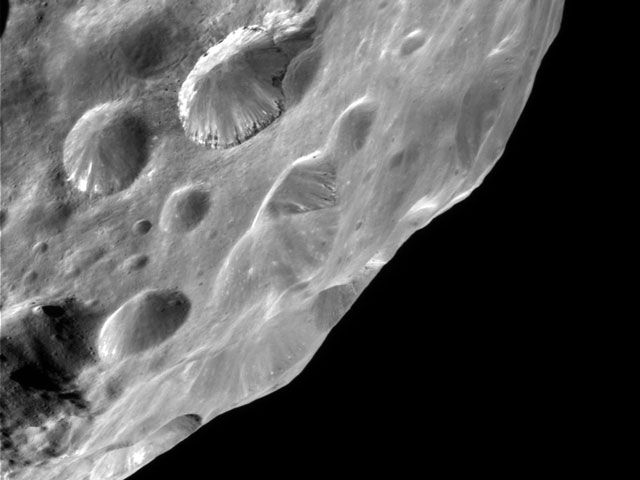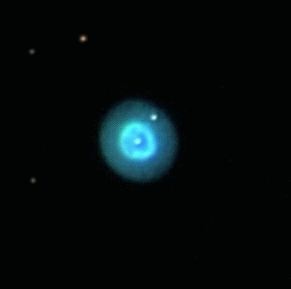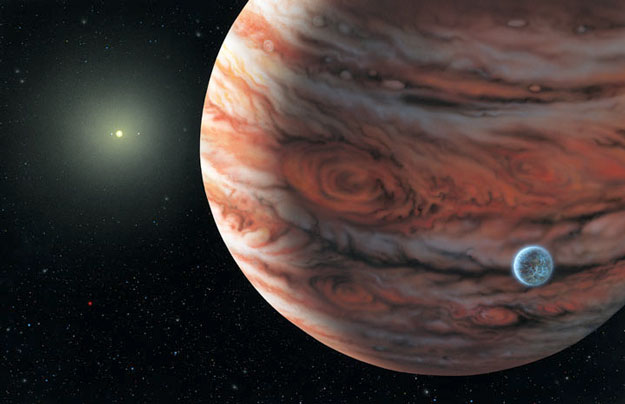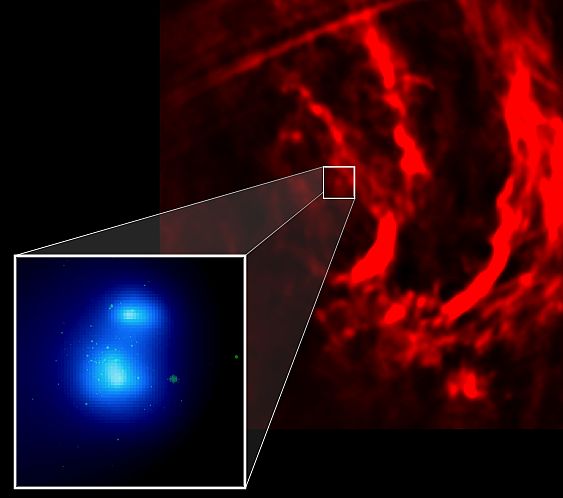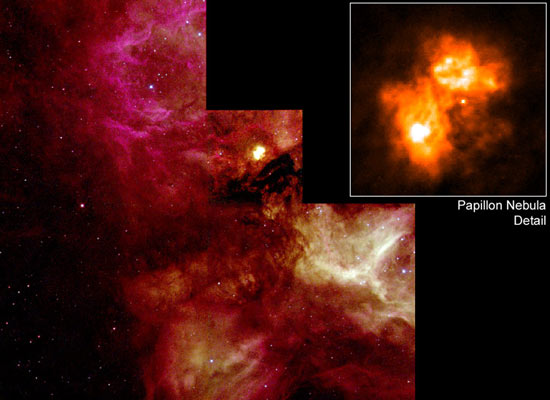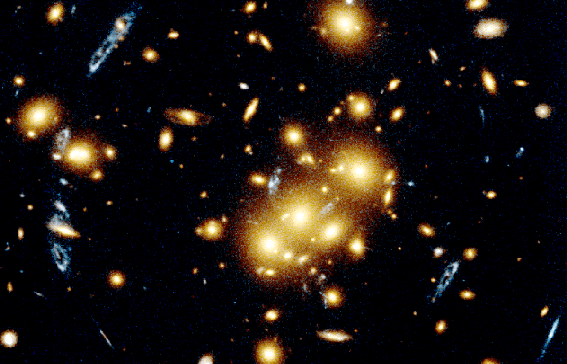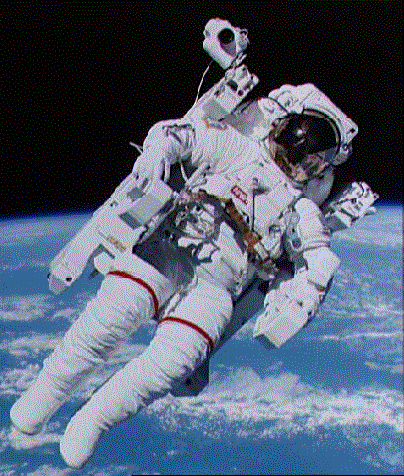| << Previous | Index | Next >> |
2015
2014 Bright stars of Sagittarius and the center of our Milky Way Galaxy lie just off the wing of a Boeing 747 in this astronomical travel photo. The stratospheric scene was captured earlier this month during a flight from New York to London, 11,000 meters above the Atlantic Ocean. Of course the sky was clear and dark at that altitude, ideal conditions for astronomical imaging. But there were challenges to overcome while looking out a passenger window of the aircraft moving at nearly 1,000 kilometers per hour (600 mph). Over 90 exposures of 30 seconds or less were attempted with a fast lens and sensitive camera setting, using a small, flexible tripod and a blanket to block reflections of interior lighting. In the end, one 10 second long exposure resulted in this steady and colorful example of airborne astronomy.
2013 Sharpless 115 stands just north and west of Deneb, the alpha star of Cygnus the Swan in planet Earth's skies. Noted in the 1959 catalog by astronomer Stewart Sharpless (as Sh2-115) the faint but lovely emission nebula lies along the edge of one of the outer Milky Way's giant molecular clouds, about 7,500 light-years away. Shining with the light of ionized atoms of hydrogen, sulfur, and oxygen in this Hubble palette color composite image, the nebular glow is powered by hot stars in star cluster Berkeley 90. The cluster stars are likely only 100 million years old or so and are still embedded in Sharpless 115. But the stars' strong winds and radiation have cleared away much of their dusty, natal cloud. At the emission nebula's estimated distance, this cosmic close-up spans just under 100 light-years.
2012 In 1716, English astronomer Edmond Halley noted, "This is but a little Patch, but it shews itself to the naked Eye, when the Sky is serene and the Moon absent." Of course, M13 is now modestly recognized as the Great Globular Cluster in Hercules, one of the brightest globular star clusters in the northern sky. Telescopic views reveal the spectacular cluster's hundreds of thousands of stars. At a distance of 25,000 light-years, the cluster stars crowd into a region 150 light-years in diameter, but approaching the cluster core upwards of 100 stars could be contained in a cube just 3 light-years on a side. For comparison, the closest star to the Sun is over 4 light-years away. Along with the cluster's dense core, the outer reaches of M13 are highlighted in this sharp color image. The cluster's evolved red and blue giant stars show up in yellowish and blue tints.
2011 What does the universe nearby look like? This plot shows nearly 50,000 galaxies in the nearby universe detected by the Two Micron All Sky Survey (2MASS) in infrared light. The resulting image is anincredible tapestry of galaxies that provides limits on how the universe formed and evolved. The dark band across the image center is blocked by dust in the plane of our own Milky Way Galaxy. Away from the Galactic plane, however, each dot represents a galaxy, color coded to indicate distance. Bluer dots represent the nearer galaxies in the 2MASS survey, while redder dots indicating the more distant survey galaxies that lie at a redshift near 0.1. Named structures are annotated around the edges. Many galaxies are gravitationally bound together to form clusters, which themselves are loosely bound into superclusters, which in turn are sometimes seen to align over even larger scale structures.
2010 How was the unusual Red Rectangle nebula created? At the nebula's center is an aging binary star system that surely powers the nebula but does not, as yet, explain its colors. The unusual shape of the Red Rectangle is likely due to a thick dust torus which pinches the otherwise spherical outflow into tip-touching cone shapes. Because we view the torus edge-on, the boundary edges of the cone shapes seem to form an X. The distinct rungs suggest the outflow occurs in fits and starts. The unusual colors of the nebula are less well understood, however, and current speculation holds that they are partly provided by hydrocarbon molecules that may actually be building blocks for organic life. The Red Rectangle nebula lies about 2,300 light years away towards the constellation of the Unicorn (Monoceros). The nebula is shown above in unprecedented detail as captured recently by the Hubble Space Telescope. In a few million years, as one of the central stars becomes further depleted of nuclear fuel, the Red Rectangle nebula will likely bloom into a planetary nebula.
2009 The center of our Milky Way Galaxy is hidden from the prying eyes of optical telescopes by clouds of obscuring dust and gas. But in this stunning vista, the Spitzer Space Telescope's infrared cameras, penetrate much of the dust revealing the stars of the crowded galactic center region. A mosaic of many smaller snapshots, the detailed, false-color image shows older, cool stars in bluish hues. Reddish glowing dust clouds are associated with young, hot stars in stellar nurseries. The very center of the Milky Way was only recently found capable of forming newborn stars. The galactic center lies some 26,000 light-years away, toward the constellation Sagittarius. At that distance, this picture spans about 900 light-years.
2008
2007 Described as a "dusty curtain" or "ghostly apparition", mysterious reflection nebula vdB 152 really is very faint. It lies about 1400 light-years away, along the northern Milky Way in the royal constellation Cepheus. Near the edge of a large molecular cloud, pockets of cosmic dust in the region block light from background stars or scatter light from the embedded bright star (top) giving parts of the nebula a characteristic blue color. Ultraviolet light from the star is also thought to cause a dim reddish luminescence in the nebular dust. Though stars do form in molecular clouds, this star seems to have only accidentally wandered into the area, as its measured velocity through interstellar space is very different from the cloud's velocity. This deep telescopic image spans about 7 light-years at the estimated distance of vdB 152.
2006 These three bright nebulae are often featured in telescopic tours of the constellation Sagittarius and the crowded starfields of the central Milky Way. In fact, 18th century cosmic tourist Charles Messier cataloged two of them; M8, the nebula below and right of center, and colorful M20 at the upper right. The third, NGC 6559, is left of M8, separated from the the larger nebula by a dark dust lane. All three are stellar nurseries about five thousand light-years or so distant. The expansive M8, over a hundred light-years across, is also known as the Lagoon Nebula while M20's popular moniker is the Trifid. This stunning digital view is actually a collaborative composite recorded by 2 cameras and 2 telescopes about 2 thousand miles apart. The deep, wide image field was captured under dark Arizona skies. Both M8 and M20 were recorded in more detail from an observatory in Pennsylvania. Glowing hydrogen gas creates the dominant red color of the emission nebulae, with contrasting blue hues, most striking in the Trifid, due to dust reflected starlight.
2005
2004 What caused the unusual light and dark layers on Saturn's moon Phoebe? The layers were discovered just Friday during the Cassini spacecraft flyby of the small moon. Such layering is particularly evident on the crater just above the image center, where alternating light and dark material makes this crater appear particularly structured. Cassini scientists speculate that such layering might result from an impact where a dark surface layer becomes intertwined with a lighter subsurface ice layer. The above image spans about 80 kilometers and was taken when Cassini was only about 13,000 kilometers from Phoebe. At the end of June, the Cassini spacecraft will be instructed to fire its thrusters to decelerate into orbit around Saturn.
2003 What do the Owl, the Cat's Eye, the Ghost of Jupiter, and Saturn have in common? They're all planetary nebulae of course, glowing gaseous shrouds shed by dying sun-like stars as they run out of nuclear fuel. Beautiful to look at, the symmetric, planet-like shapes of these cosmic clouds, typically 1,000 times the size of our solar system, evoke their popular names. Flipping through digital pictures made by participants in the Kitt Peak National Observatory Visitor Center's Advanced Observing Program, astronomer Adam Block created this delightful animation. Ten different planetary nebula images are presented, each registered on the central star. In order, their catalog designations are NGC 1535, NGC 3242 (Ghost of Jupiter), NGC 6543 (Cat's Eye), NGC 7009 (Saturn Nebula), NGC 2438, NGC 6772, Abell 39, NGC 7139, NGC 6781, and M97 (Owl Nebula). This glorious final phase in the life of a star lasts only about 10,000 years.
2002 Is our Solar System unique? The discovery of a Jupiter-like planet in a Jupiter-like orbit around nearby Sun-like star 55 Cancri, announced yesterday, gives a new indication that planetary systems similar to our Solar System likely exist elsewhere. The planet, discovered by G. Marcy (UC Berkeley) and collaborators, is one of two new planets found around 55 Cancri -- in 1997 a Jupiter-massed planet was found orbiting very close in. The finding involved noting subtle changes in the speed of the star caused by its orbiting planets. The above drawing depicts what this planet might look like, complete with a hypothetical moon. The star 55 Cancri, only 40 light-years distant, is visible with binoculars towards the constellation of Cancer.
2001 The most compact cluster of stars known in our galaxy, the Arches cluster, boasts 100 or so massive, young stars contained within a diameter of one light-year. Seen toward the constellation Sagittarius, the Arches cluster is about 25,000 light-years from planet Earth and lies within a scant 100 light-years of the supermassive black hole believed to lurk in our Milky Way Galaxy's center. This combination of images in radio, infrared, and x-ray light illustrates this star cluster's bizarre galactic neighborhood. Shown in red, radio emission traces the filamentary arching structures near the galactic center around the Arches cluster location. Within the zoomed inset box, infrared image data shows some of the cluster's individual stars as bright point-like sources. The diffuse emission in blue surrounding the cluster stars is a false-color x-ray image of an enveloping cloud of 60 million degree gas -- the first time such an energetic star cluster halo has been detected. Astronomers consider the tightly packed and relatively nearby Arches cluster, an analog of the furious star forming regions in galaxies millions of light-years away.
2000 What can 100,000 galaxies tell you? Perhaps the structure and composition of the universe. Astronomers using the Two Degree Field (2dF) spectrograph on the Anglo-Australian Telescope (AAT) in Australia have now measured the redshifts of over 100,000 galaxies in a thin ribbon of the sky. The results show how galaxies are scattered in the universe out to 4 billion light years. Huge clusters, long filaments, and empty voids measuring over 100 million light years across are visible in the resulting 2dF map, pictured above. The map is interesting not only for what it shows but also for what it does not show. It does not show even larger structures that would be expected were the universe filled to critical density with normal matter. These results do not contradict recent evidence that most of the universe is made of some type of unusual dark energy, however.
1999 In a search for massive stars, the Hubble Space Telescope has peered into yet another spectacular region of star formation. This nebula, known as N159, spans over 150 light-years and is located in the neighboring Large Magellanic Cloud galaxy, about 170,000 light years distant. Visible in the above picture are bright newborn stars, dark filaments of dust, and red-glowing hydrogen gas. The aptly named Papillon Nebula (French for butterfly), is the unusual central compact cloud, highlighted in the inset. Reasons for the bipolar shape of the Papillon Nebula are currently unknown, but might indicate the presence of unseen high-mass stars and a thick gaseous disk.
1998 What are those strange blue objects? Many are images of a single, unusual, beaded, blue, ring-like galaxy which just happens to line-up behind a giant cluster of galaxies. Cluster galaxies here appear yellow and -- together with the cluster's dark matter -- act as a gravitational lens. A gravitational lens can create several images of background galaxies, analogous to the many points of light one would see while looking through a wine glass at a distant street light. The distinctive shape of this background galaxy -- which is probably just forming -- has allowed astronomers to deduce that it has separate images at 4, 8, 9 and 10 o'clock, from the center of the cluster. Possibly even the blue smudge just left of center is yet another image! This spectacular photo from HST was taken in October 1994. The first cluster lens was found unexpectedly by Roger Lynds (NOAO) and Vahe Petrosian (Stanford) in 1986 while testing a new type of imaging device. Lensed arcs around this cluster, CL0024+1654, were first discovered from the ground by David Koo (UCO Lick) in 1988.
1997
1996 NASA astronauts can float free in space without any connection to a spaceship. Here astronaut Bruce McCandless maneuvers outside the Space Shuttle Challenger by firing nitrogen gas thrusters on his manned maneuvering unit (MMU). This picture was taken in 1984 and records this first untethered spacewalk. The MMU was developed because astronauts found tethers restrictive.
| << Previous | Index | Next >> |
